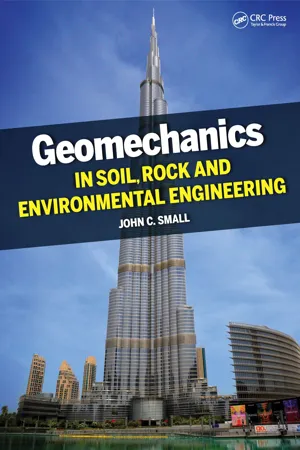
- 541 pages
- English
- ePUB (mobile friendly)
- Available on iOS & Android
Geomechanics in Soil, Rock, and Environmental Engineering
About This Book
Utilizes both Computer- and Hand-Based Calculations…
Modern practice in geomechanics is becoming increasingly reliant on computer-based software, much of which can be obtained through the Internet. In Geomechanics in Soil, Rock, and Environmental Engineering the application of these numerical techniques is examined not only for soil mechanics, but also for rock mechanics and environmental applications.
… For Use in Complex Analysis
It deals with the modern analysis of shallow foundations, deep foundations, retaining structures, and excavation and tunneling. In recent years, the environment has become more and more important, and so it also deals with municipal and mining waste and solutions for the disposal and containment of the waste. Many fresh solutions to problems are presented to enable more accurate and advanced designs to be carried out.
A Practical Reference for Industry Professionals, This Illuminating Book:
-
- Offers a broad range of coverage in soil mechanics, rock mechanics, and environmental engineering
- Incorporates the author's more than 40 years of academic and practical design experience
- Describes the latest applications that have emerged in the last ten years
- Supplies references readily available online for futher research
Geomechanics in Soil, Rock, and Environmental Engineering
should appeal to students in their final undergraduate course in geomechanics or master's students, and should also serve as a useful reference to practitioners in the field of geomechanics, reflecting the author's background in both industry and academia.
Frequently asked questions
Information
(1.1) |
(1.2) |
(1.3) |

(1.4) |
(1.5) |
(1.6) |
(1.7) |
(1.8) |
Table of contents
- Cover
- Half Title
- Title Page
- Copyright Page
- Table of Contents
- Preface
- Acknowledgments
- 1 Basic concepts
- 2 Finite layer methods
- 3 Finite element methods
- 5 Shallow foundations
- 6 Deep foundations
- 7 Slope stability
- 8 Excavation
- 9 Retaining structures
- 10 Soil improvement
- 11 Environmental geomechanics
- 12 Basic rock mechanics
- References
- Index